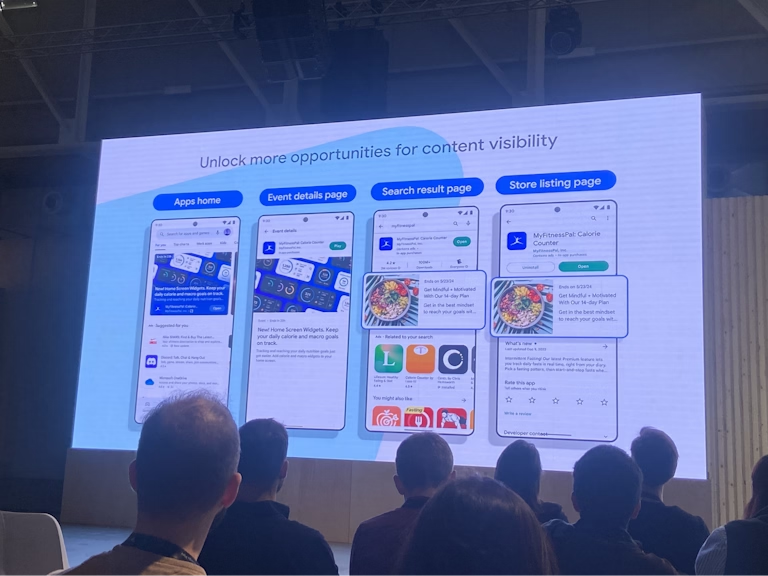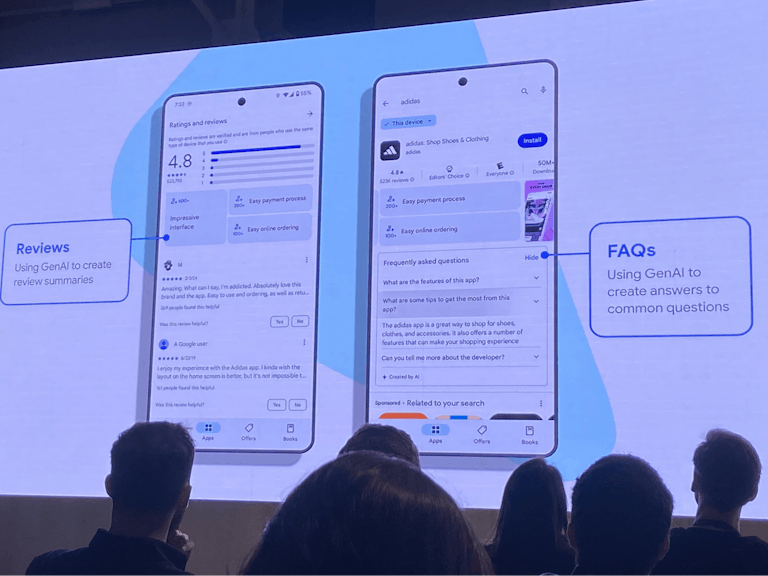
Google PlayTime recap: Google Play’s vision for 2025
PlayTime is Google Play’s exclusive event for app publishers, where the Google Play team unveils updates, upcoming features, and strategic priorities for the year. For app and game publishers, it’s an opportunity to connect with Google, understand the direction of the Play Store, and get a preview of powerful growth tools only available to larger apps.
I had the opportunity to attend the event this year. Here’s a short recap of the main updates that app marketers should have on their radar.
The big picture: Expanding beyond acquisition
The key message I took away from the day is that Google is looking to grow the Play Store from “just” an acquisition platform to a larger experience that supports apps & games in their effort to engage audiences. This means providing new tools to help apps not only attract but also engage users with customized, intent-driven interactions.
1. Collections: engaging users where they are
Google shared that only 18,5% of apps installed on a device are opened daily. To encourage more engagement, Google is betting big on Collections. Collections, currently rolling out in the US, provide users with an immersive, curated space on their device’s home screen, allowing app developers to more easily showcase new content to their users.
By using data from Google’s “Engage” SDK, Collections can:
- Nudge a user to resume a dropped user journey and prompt them to return to unfinished tasks, like resuming a video or revisiting a cart.
- Highlight new content or features users may have missed.
- Promote relevant deals and promotions.

Collections will roll out globally in Q2 2025, eligible games and four more app categories (Health & Fitness, Sports, Travel, Events, and Dating) will be able to leverage this feature.
2. Promotional Content: driving more visibility
There was a big focus on Promotional Content during the event, sharing some great case studies on how Promotional Content is boosting discoverability and engagement. Google emphasized the prominence of Promotional Content is only expected to grow, and highlighted new features they are rolling out to make Promotional Content even more impactful:
- Deep Linking: Publishers can now link directly to specific in-app content
- Expanded Targeting Options: Publishers can define specific audience segments allowing promotional content to reach more relevant audiences.

3. Custom store listings: Boosting user loyalty
Custom Store Listings (CSLs) were another key focus, with Google emphasizing their value in reaching specific user segments with tailored messaging. Google shared some impressive results, like a median 10% lift in conversion rates for CSLs used in Google Ad campaigns and an 8% boost in conversion for the keyword “podcast” in Audible’s listing.
With CSLs, Google is encouraging developers to think beyond the one-size-fits-all approach. By creating listings that speak directly to a user’s interests or demographics, developers can drive more meaningful engagement and higher conversions. While no major feature updates were announced for CSLs at PlayTime, Google’s emphasis on this tool reinforces its vision for a more personalized Play Store experience.
4. Videos: Vertical formats for higher engagement
Developers can now upload portrait-oriented videos to their Play Store listings, which are displayed in a full-screen, immersive format. This immersive design includes a prominent “install” button to drive conversions. Google reports that portrait videos have led to a 7% increase in total watch time, a 9% rise in video completions, and a 5% boost in conversions.
Soon, app and game developers will be able to link their store listing to a YouTube channel or playlist, allowing visitors to watch recent videos from within the Play Store. Videos uploaded within the last 90 days will be displayed in a carousel format, potentially increasing engagement with existing users and boosting app opens and reinstalls. Early pilot projects for this feature showed encouraging uplifts in app re-engagement, indicating that a YouTube integration could be particularly valuable for apps with regular content updates or seasonal campaigns.
5. AI-generated review summaries & FAQs
Google is introducing AI-generated summaries of app reviews, offering users a quicker, more comprehensive view of an app’s strengths and weaknesses. Additionally, Google might leverage AI to display FAQs and formulate answers to common questions.

Conclusion
Google’s roadmap for 2025 reflects a major shift toward holistic user engagement, moving beyond pure acquisition to support publishers in retention and monetization. As app marketers, these tools and updates offer new opportunities to refine user targeting, drive personalized experiences, and ultimately expand app growth beyond downloads.
If you want to stay up to date with ASO news, don’t forget to sign up to AppTweak and regularly visit our blog!


 Sukanya Sur
Sukanya Sur

 Rachana Pinto
Rachana Pinto